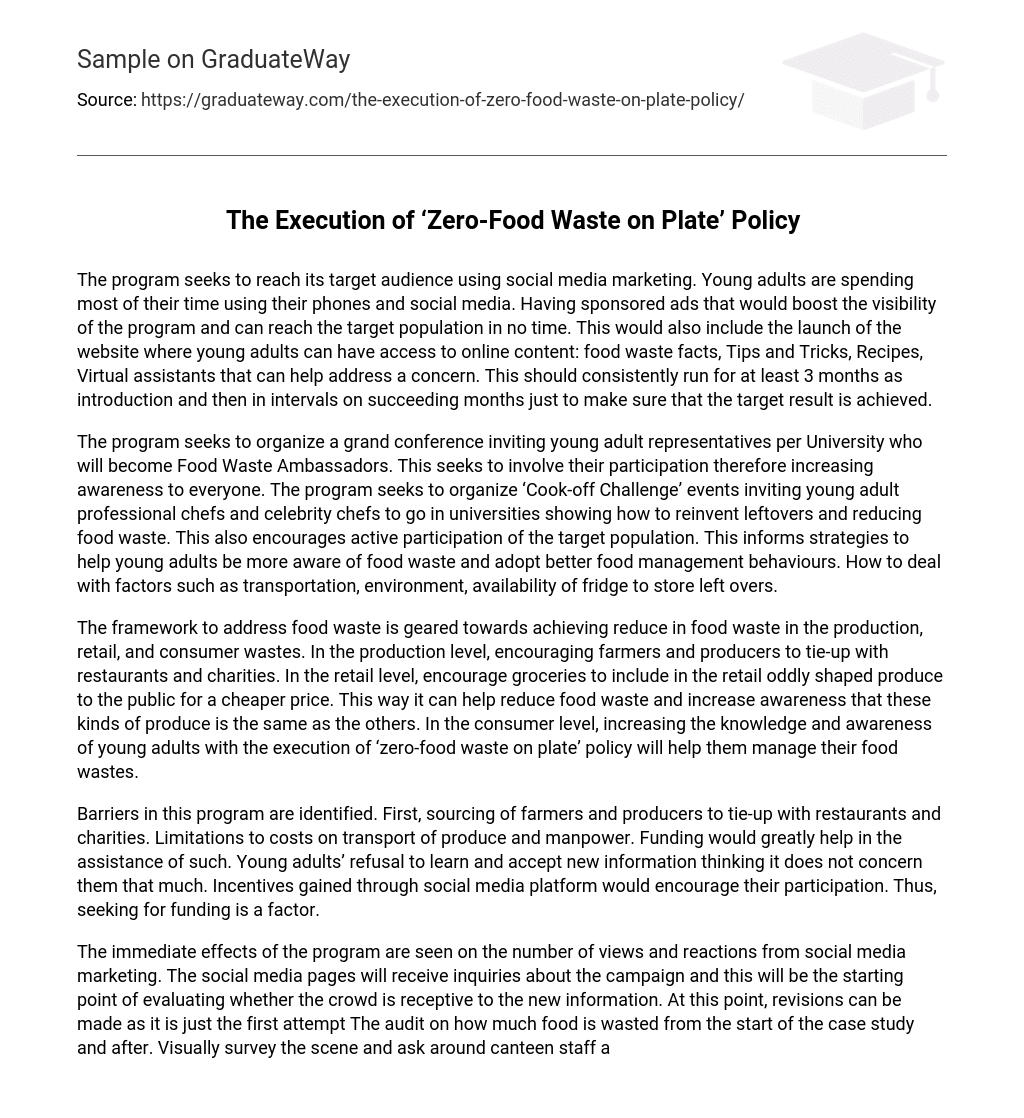The program seeks to reach its target audience using social media marketing. Young adults are spending most of their time using their phones and social media. Having sponsored ads that would boost the visibility of the program and can reach the target population in no time. This would also include the launch of the website where young adults can have access to online content: food waste facts, Tips and Tricks, Recipes, Virtual assistants that can help address a concern. This should consistently run for at least 3 months as introduction and then in intervals on succeeding months just to make sure that the target result is achieved.
The program seeks to organize a grand conference inviting young adult representatives per University who will become Food Waste Ambassadors. This seeks to involve their participation therefore increasing awareness to everyone. The program seeks to organize ‘Cook-off Challenge’ events inviting young adult professional chefs and celebrity chefs to go in universities showing how to reinvent leftovers and reducing food waste. This also encourages active participation of the target population. This informs strategies to help young adults be more aware of food waste and adopt better food management behaviours. How to deal with factors such as transportation, environment, availability of fridge to store left overs.
The framework to address food waste is geared towards achieving reduce in food waste in the production, retail, and consumer wastes. In the production level, encouraging farmers and producers to tie-up with restaurants and charities. In the retail level, encourage groceries to include in the retail oddly shaped produce to the public for a cheaper price. This way it can help reduce food waste and increase awareness that these kinds of produce is the same as the others. In the consumer level, increasing the knowledge and awareness of young adults with the execution of ‘zero-food waste on plate’ policy will help them manage their food wastes.
Barriers in this program are identified. First, sourcing of farmers and producers to tie-up with restaurants and charities. Limitations to costs on transport of produce and manpower. Funding would greatly help in the assistance of such. Young adults’ refusal to learn and accept new information thinking it does not concern them that much. Incentives gained through social media platform would encourage their participation. Thus, seeking for funding is a factor.
The immediate effects of the program are seen on the number of views and reactions from social media marketing. The social media pages will receive inquiries about the campaign and this will be the starting point of evaluating whether the crowd is receptive to the new information. At this point, revisions can be made as it is just the first attempt The audit on how much food is wasted from the start of the case study and after. Visually survey the scene and ask around canteen staff and cleaners about the change. The long-term effect should include young adults’ reducing food waste practices. Significant decrease of food waste from bins and landfills.
Data sources will come from local food charities in Australia who share the same advocacy. Examples are: Foodbank, FareShare, SecondBite and OzHarvest. The solutions to potential risks are, modifying the program suitable to the knowledge and skills, attitudes, behaviours, and preferences of young adults. Knowing how they would want the approach would be more effective in incorporating it to their lifestyles. For farmers and producers wasting produce to be penalized and fined for landfill wastes. For retailers who does not abide with the new policy that they will be receiving penalties and pay fines. Worst case scenario is possible suspension of business permits. The resources will come from stake holders, interested funders, and other non-profit organizations.
Researchers will be invited to create research studies that can help in the improvement of the program, statisticians to collect data that will help analyse the lapses in the program, IT personnel to develop a website and software platform that can be used to monitor food waste pre- and post- program activities. Data collection and shared their views of challenges and opportunities related to food waste data collection, including Australian based food banks and programs such as: Zero Waste South Australia, Foodwise:Do something, and other stakeholders that provided information.
Distribute the findings to the government by research data and results regarding the transformation changes from the beginning to the end of the program. There will be continuous and ongoing social media content, fliers, posters, television and radio campaigns on food waste so that it could reach the lay audience. Sustainability in funding can be achieved through affiliations to farmers, producers, and retail stores. They could provide raw materials that can create meals or food packages that could be retailed and sold to consumers. The visibility of the campaign would reach stakeholders and funders to be enticed to fund the program. Sponsorship from big food companies would also help in the funding aspect.





